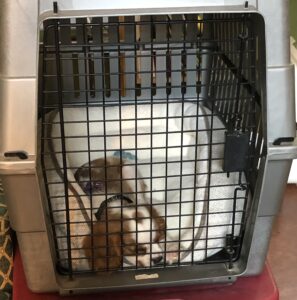I have always had success crate training dogs. I think a lot of that success has to do with my mindset about crate training. Instead of looking at it from the human perspective, I look at it from the dog’s perspective. What do I mean by that? Well, when I ask most clients why they want to crate train, they tell me so that their dog won’t tear up things when they are gone, go to the bathroom in the house, or get into things they shouldn’t. Granted all valid reasons, but what’s in it for the dog?
I think of crate training this way. A dog needs a cushy place to relax. A place where he isn’t bothered by the kids, where lots of good stuff is within reach and he can just zone out. With this in mind, my approach is how do I create this for my dog and show him how to enjoy his new “chill zone”.
Like most trainers I want to create a great first impression of the crate. I do so by putting it in a comfortable spot – a place the dog likes to hang out. For me, that’s in the living room and in my office. I want to make the crate inviting so I leave the door off or propped open. To make it even more inviting I put my dog’s favorite towel or blanket inside, a water dish that attaches so it won’t spill and then I put a few little surprise food treats inside. I set all of these things up without the dog around. Then I let the dog in and allow him to discover the crate on his own, without me even around. I usually give them about 3 minutes alone exploring. I usually return to find the dog rummaging inside the crate to find his toys or the treats I’ve tossed in.
When I see him interacting with the crate, I act interested. I say, “what did you find in there, boy?”, and I get down on my hands and knees to take a look. If the dog goes back in, I praise and reward him. If he doesn’t – no big deal, we go on to other things.
Later, after he has almost forgotten the crate, I will go and put another surprise in it. Maybe a special treat or bone. Eventually, he’ll smell the treat or bone and go into the crate to get it. He Probably won’t stay in the crate. He will likely take the bone or treat out. That’s ok because he will remember where the treat or bone came from, and next time he is looking for something appetizing or fun, he’ll go check out the crate. My job is to make sure he finds something great.
 Once, he understands that good things are found in the crate, then I will start a little formal training. With treats and a clicker I will start to shape going in the crate. If I go near the crate, the dog will likely go in an explore, or at least stick his head in just to check and see if there might be something good in there. When he does, I click and toss the treat outside the crate. He will likely eat the treat and then return to the crate. I will continue to shape the behavior until the dog is entering the crate easily. Then, I will put entering the crate on cue. My cue is usually “Kennel”. I will say the word as he is about to enter the kennel anyway. This gets him to associate the word with the action of going in the crate. Just in case you are wondering, I still have not installed the door or allowed it to ever shut.
Once, he understands that good things are found in the crate, then I will start a little formal training. With treats and a clicker I will start to shape going in the crate. If I go near the crate, the dog will likely go in an explore, or at least stick his head in just to check and see if there might be something good in there. When he does, I click and toss the treat outside the crate. He will likely eat the treat and then return to the crate. I will continue to shape the behavior until the dog is entering the crate easily. Then, I will put entering the crate on cue. My cue is usually “Kennel”. I will say the word as he is about to enter the kennel anyway. This gets him to associate the word with the action of going in the crate. Just in case you are wondering, I still have not installed the door or allowed it to ever shut.
By now, my dog thinks the crate is the bomb! He loves going in. He can do it on cue, and when he chooses to go in, he always finds something great. Now I need to teach him to relax while he is in there. I do this by recognizing times when he is most likely to lie down and chill. For most of my dogs it is late morning or late afternoon, after a long stretch of activity.
I have always used stuffed Kongs to help my dogs chill out. For example, If I need to cook dinner, rather than have a puppy running under foot, I just give him his dinner in a kong behind a baby gate in another room. It works well. I will use a similar technique to teach chill in the crate.
I have devised a way to tie a stuffed kong in the crate. What I do is run a cord or cable through the small end of the Kong and through the large end. I then tie a big knot so that the kong hangs from the cord. I then stuff it with something long lasting like peanut butter, easy cheese, or whipped cream. I usually freeze them but not always. I will then, attach the kong inside the crate, to the back so the dog can lick and chew on it, but not carry it out. Like always, I do this with the dog out of site and then let him in to find it on his own. My dogs have always been happy at this point to just lie down and lick on the Kong for a good long time. It usually takes about 15 minutes for my dogs to lick one of these Kongs clean, so in this case, I call them out of the crate at 10 minutes (while there is still some goodness left), and I close the crate door locking them out of it. Dramatic, I know! My dogs will usually pitch a fit, but I just ignore it. Eventually they will get distracted by something else.
I will do this dirty Kong trick 4 or 5 times over the course of a couple of days. I will even close the door with a fully stuffed Kong inside and let the dog beg his way into it. I also continue to leave toys and treat hidden in the crate.
What I have found is that by this point in the game, my dogs will regularly go into the crate and take naps, or just chill or lick a bone or Kong. They will often, when given a bone, take it to the crate to relax and eat it. This is the point where I start shutting the door.
I will see my dog go into the crate, primed and ready for a nap. Once he settles, I gently shut the door. My dog doesn’t care. He is comfy. He closes his eyes and settles in for a nap. I go about the house doing my own things. I keep an eye on him though because I don’t want him to wake and feel trapped. After a while a see that he is awakened. I go to the kennel, and open the door and walk away. Sometimes, he comes out, sometimes he just goes back to sleep.
I will continue these things for a few weeks. Like magic, my dog learns to love his crate, go in on cue, and stay for reasonable amounts of time with the door closed. He will stay quietly whether I am present or not. He will often choose to go in the crate on his own accord. I continue to randomly leave gifts of treats and toys inside. He now LOVES the “chill zone” I’ve created for him.

While most dogs take to crate training easily, some have been traumatized by people trying to “get them used to “ the crate. They have been forced into a box and left alone with nothing to do for long periods of time. Some of these dogs, and dogs with other anxiety issues will never be able to be crate trained. This is not the end of the world. A positive reinforcement trainer can help train other options you and your dog will love.
The bottom line for me, is that the secret to crate training is not how you get your dog used to it, but how you get him to LOVE it! That is always my goal in my training – getting dogs to love doing what I want them to do.






0 Comments